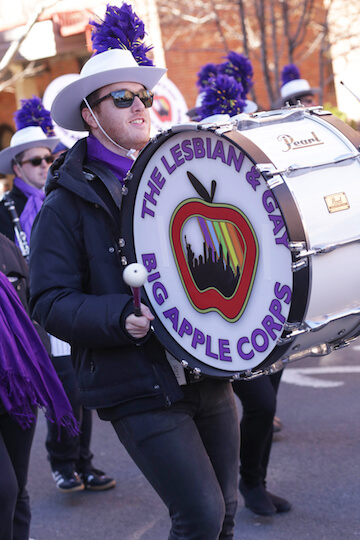Edie Windsor (r.), with her late spouse Thea Spyer. | NYCLU.ORG
By the time the next issue of Gay City News hits the streets on March 27, the US Supreme Court will be concluding two days of oral arguments on the two marriage equality cases it accepted for review in the current term.
On March 26, the federal lawsuit challenging the Defense of Marriage Act filed by Edie Windsor — assessed more than $360,000 in federal estate taxes after her spouse Thea Spyer died in 2009 — will be heard. Windsor’s attorneys at the American Civil Liberties Union will be opposed by Paul Clement, a private attorney representing the so-called Bipartisan Legal Advisory Group of the House of the Representatives, which is controlled by Republican Speaker John Boehner. BLAG stepped into the DOMA litigation in 2011 after the Justice Department, having determined the 1996 law is unconstitutional, said it would no longer defend it in court.
It was, in fact, the Obama administration that asked the high court to take up the case to settle the question of DOMA’s constitutionality. The Justice Department filed a brief in the case, arguing that laws treating gay and lesbian people differently should be subjected to the most searching form of judicial scrutiny — one that requires a showing of a compelling public purpose served, in narrowly tailored fashion, by the distinction. Viewed in that light, DOJ argues, DOMA cannot possibly survive. BLAG’s argument that the purpose of marriage is to promote responsible procreation by heterosexuals, the administration asserts, does not even meet minimal judicial standards of being rational.
Arguments against DOMA may find a receptive ear among some of the court’s conservatives. The law was the federal government’s first significant legislative incursion in history into regulating marriage, something traditionally reserved to the states — so long (like in the case of the Supreme Court’s 1967 ruling on interracial marriage) as minimal federal constitutional guarantees are protected.
Should the high court, or a few conservatives on it, conclude the federal government overreached in enacting DOMA, the victory should go to Windsor. Liberals on the court are likely to agree with the ACLU’s assertion that even the most lenient scrutiny of the 1996 law would find no constitutionally valid reason for its enactment. That scenario would allow the court to strike down DOMA without resolving the more challenging question before it — whether, like claims of racial and gender discrimination, lawsuits alleging sexual orientation bias merit the most stringent judicial review.
The high court has not yet tackled that question — and for its majority, that may yet be a bridge too far. Finding that DOMA lacks even a minimal rationale would be the easiest route to victory for our side.
The issue of what level of scrutiny federal courts apply to sexual orientation discrimination claims may have greater impact on the resolution of the other marriage equality case — the American Foundation for Equal Rights (AFER) challenge to California’s Proposition 8. At the district court, AFER won a sweeping victory that found that same-sex couples have a federal constitutional right to marry. An appeals court, while affirming AFER’s victory , did so on the narrower ground that no non-discriminatory reason could be found for California voters choosing to take away a right to marry that same-sex couples already enjoyed.
The Supreme Court could conceivably uphold that finding even while applying the most lenient form of review. In 1996, it struck down a Colorado voter initiative that denied gay and lesbian couples the right to enact nondiscrimination laws. Such a victory for AFER would restore marriage equality to California without confronting the bigger questions of a federal constitutional right to marriage or whether claims of anti-gay discrimination subject the law in question to tougher scrutiny.
AFER, of course, is aiming higher, with arguments that could provoke a bigger victory — of one of two sizes. The court might conclude that any state that gives couples all the rights and benefits of marriage, but denies them access to marriage itself — as California with its existing domestic partnership law and the seven other domestic partnership/ civil union states do — is acting unconstitutionally since the only possible explanation for distinguishing in name between two otherwise identical institutions is impermissible bias.
Or the court could wipe the whole issue off the table by embracing the sort of sweeping ruling AFER won at the district court. Making that bet with the court’s current composition seems bold — and Jeffrey Toobin’s profile of “liberal” Justice Ruth Bader Ginsburg in a recent issue of the New Yorker (in which he cited a 1992 speech where she argued the 1972 Roe v. Wade abortion case was decided more sweepingly than it needed to be) should give any optimist pause.
Still, everything is now on the table and any outcome — including some procedural dodge on deciding one or both of the cases — is possible. The arguments will be over on March 27, but the suspense could last through the end of June. Come what may, this is certainly among the most profound moments in the history of LGBT rights in America. And many, many advocates and activists can justly be proud that we’ve come to this precipice.



































